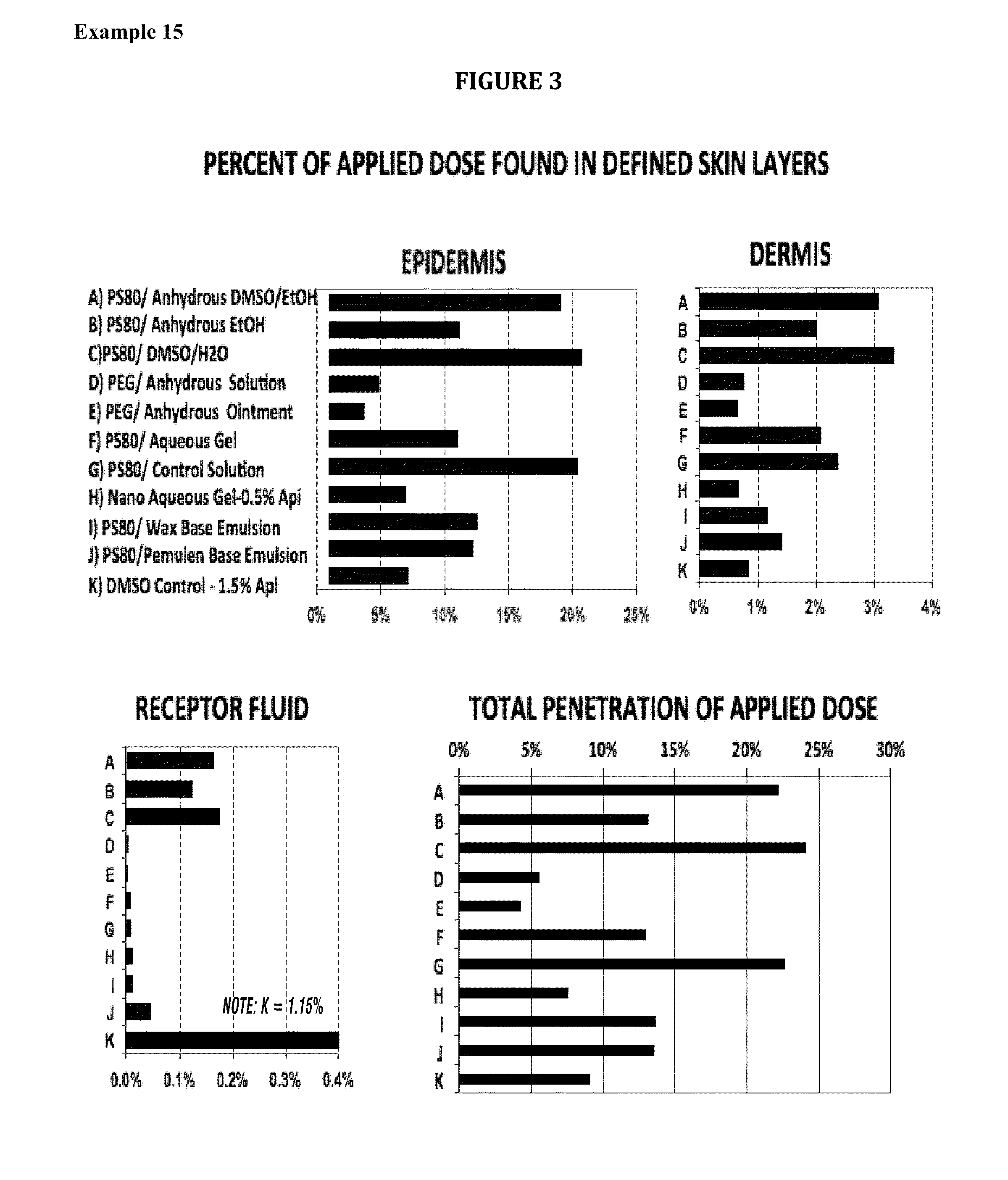Methods of increasing solubility of poorly soluble compounds and methods of making and using formulations of such compounds
a technology of poorly soluble compounds and solubility, which is applied in the direction of drug compositions, antiparasitic agents, dispersed delivery, etc., can solve the problems of skin cancer, a major global public health threat, and a severely limited drug efficacy, so as to reduce/or prevent the effect of sun exposur
- Summary
- Abstract
- Description
- Claims
- Application Information
AI Technical Summary
Benefits of technology
Problems solved by technology
Method used
Image
Examples
example 1
[0343]The Apigenin and Polysorbate 80 resulting product is referred to as “A / PS80”. A / PS80 was formed as follows:[0344]The unprocessed apigenin powder & viscous liquid polysorbate 80 (PS80) were mixed in the ratio from about 5 to 10 wt % of apigenin to 95 to 90 wt % polysorbate 80 and a small quantity of D.I. water and optionally acetone and / or ethyl alcohol in a beaker.[0345]This mixture was then thoroughly stirred to form a thick paste-like blend.[0346]The mixture was then slowly heated to relatively high temperatures while stirring. The heating was accompanied by the boiling off of the water and also volatile constituents present in the polysorbate 80. The heating process was conducted with care to avoid the mixture overflowing from the beaker due to foaming resulting from the heating process.[0347]Upon the removal of the volatiles and heating to temperatures in excess of about 200 to 300° C., a dark brown transparent liquid resulted such that all the so...
example 2
Solubility of Selected Flavonoid Concentrates in Polysorbate 80 and PEG 400 as Determined by HPLC
[0353]The objective of this work was to quantify a total of six different flavonoids in PS80 and PEG-400. The samples were also analyzed qualitatively to look for signs of degradation of the solvents due to the elevated temperatures required of the thermal treatment process.
This project was divided into three distinct phases: method validation / development, quantitation of the individual flavones, and qualitative analysis to look for signs of PS80 / PEG400 degradation. Method development was performed to determine the suitability of a previously used HPLC method for Apigenin for the remaining flavonoids to be quantified in either PEG400 or PS80.
Table IX provides the HPLC measured flavonoid concentration in the as-prepared flavonoid concentrates formulated by the thermal treatment process in both PS80 and PEG-400.
TABLE IXFlavonoid Analytical Summary In Selected SolventsFlavonoid inFlavonoidS...
example 3
Additional Flavonoid Polysorbate Formulations
[0354]In addition to apigenin, testing with Polysorbate 80 was expanded to include several flavonoid compounds. Table X includes the chemical and physical property data of the flavonoids selected for solubility testing with Polysorbate 80.
TABLE XSUMMARY OF CHEMICAL & PHYSICAL PROPERTIES OF FLAVONOIDS TESTEDWATERMPSOLUBILITYPARTIAL LISTING OFCOMPOUNDMW(° C.)(mg / ml)FLAVONOID SOURCESAPPEARANCEAPIGENIN270~360* 0.00002Parsley, Thyme, Celery,Yellow Crystalline(>Sol. In alcohol)ChamomilePowderLUTEOLIN286~330* 0.38 mg / mlCelery, Oregano, Thyme.Yellow Powder(>Sol. In alcohol)ChamomileRESVERATROL228~255* 0.1 to 0.3 mg / mlRed Grapes & Red Wine,White Powder with50 mg / ml in alcoholPeanuts, Some Berriesa slight yellow castQUERCETIN302~315* Apples, Tea, Citrus, Broccoli,Yellow CrystallineBerriesPowderHESPERIDIN610~260* Values cited fromBuckwheat, Citrus,White to Yellow0.05 to 3 mg / mlCherries, GrapesPowderRUTIN610~242* 0.07 mg / mlBuckwheat, Citrus, Berries,...
PUM
| Property | Measurement | Unit |
|---|---|---|
| Temperature | aaaaa | aaaaa |
| Temperature | aaaaa | aaaaa |
| Temperature | aaaaa | aaaaa |
Abstract
Description
Claims
Application Information
 Login to View More
Login to View More - R&D
- Intellectual Property
- Life Sciences
- Materials
- Tech Scout
- Unparalleled Data Quality
- Higher Quality Content
- 60% Fewer Hallucinations
Browse by: Latest US Patents, China's latest patents, Technical Efficacy Thesaurus, Application Domain, Technology Topic, Popular Technical Reports.
© 2025 PatSnap. All rights reserved.Legal|Privacy policy|Modern Slavery Act Transparency Statement|Sitemap|About US| Contact US: help@patsnap.com



